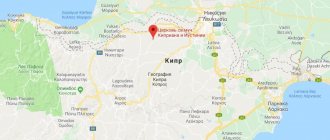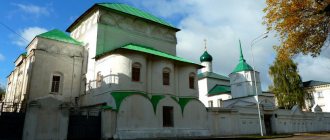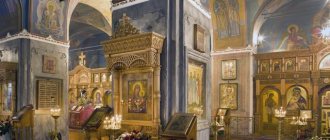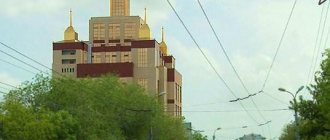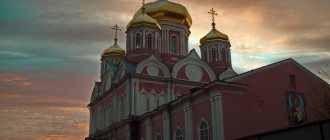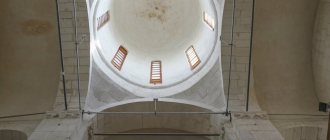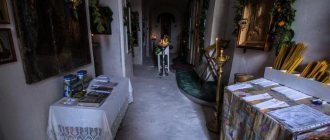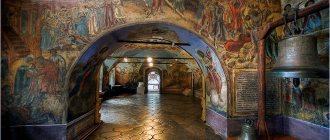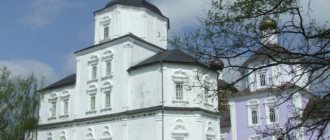Mir
Cyprus Map loading in progress...
{"format":"leaflet","minzoom":false,"maxzoom":false,"limit":50,"offset":0,"link":"all","sort":[""], "order":[],"headers":"show","mainlabel":"","intro":"","outro":"","searchlabel":"\u2026 \u0441\u043b\u0435\ u0434\u0443\u044e\u0449\u0438\u0435 \u0440\u0435\u0437\u0443\u043b\u044c\u0442\u0430\u0442\u044b","default":"","import-annotation":false,"width ":"auto","height":"400px","centre":{"text":"","title":"""link":"""lat":34.9823018000000018901118892244994640350341796875,"lon": 33.14512849999999843930709175765514373779296875,"icon":""},"title":"","label":"","icon":"","lines":[],"polygons":[], "circles":[ ],"rectangles":[],"copycoords":false,"static":false,"zoom":8,"defzoom":14,"layers":["OpenStreetMap"],"image layers":[] ,"overlays":[],"resizable":false,"fullscreen":true,"scrollwheelzoom":true,"cluster":true,"clustermaxzoom":7,"clusterzoomonclick":true,"clustermaxradius":80, "clusterspiderfy":true,"geojson":"","clicktarget":"","showtitle":true,"hidenamespace":false,"template":"","userparam":"","activeicon": "","pagelabel":false,"ajaxcoordproperty":"","ajaxquery":"","locations":[{"text":"\u003Cb\u003E\u003Ca href=\"/palomnik/%D0% 9C%D0%BE%D0%BD%D0%B0%D1%81%D1%82%D1%8B%D1%80%D1%8C_%D0%90%D0%BF%D0%BE%D1%81% D1%82%D0%BE%D0%BB%D0%B0_%D0%92%D0%B0%D1%80%D0%BD%D0%B0%D0%B2%D1%8B\» title=\»\ u041c\u043e\u043d\u0430\u0441\u0442\u044b\u0440\u044c \u0410\u043f\u043e\u0441\u0442\u043e\u043b\u0430 \u0412\u0430\u0440\u0 43d\u0430\u0432\u044b\»\ u003E\u041c\u043e\u043d\u0430\u0441\u0442\u044b\u0440\u044c \u0410\u043f\u043e\u0441\u0442\u043e\u043b\u0430 \u0412\u0430\u0 440\u043d\u0430\u0432\u044b\ u003C/a\u003E\u003C/b\u003E","title":"\u041c\u043e\u043d\u0430\u0441\u0442\u044b\u0440\u044c \u0410\u043f\u043e\u0441\u0442\u043e \u043b \u0430 \u0412\u0430\u0440\u043d\u0430\u0432\u044b","link":"","lat":35.17474200000000195132088265381753444671630859375,"lon":33.88028 59999999981255314196459949016571044921875,"icon":"/palomnik/images/f/f8 /Yellow_marker.png"},{"text":"\u003Cb\u003E\u003Ca href=\"/palomnik/%D0%9C%D0%BE%D0%BD%D0%B0%D1%81%D1%82 %D1%8B%D1%80%D1%8C_%D0%9A%D0%B8%D0%BA%D0%BA%D0%BE%D1%81\» title=\»\u041c\u043e\u043d\u0430 \u0441\u0442\u044b\u0440\u044c \u041a\u0438\u043a\u043a\u043e\u0441\»\u003E\u041c\u043e\u043d\u0430\u0441\u0442\u044b\u0440 \u044c \u041a\u0438\u043a \u043a\u043e\u0441\u003C/a\u003E\u003C/b\u003E","title":"\u041c\u043e\u043d\u0430\u0441\u0442\u044b\u0440\u044c \u041a\u0438\u04 3a\ u043a\u043e\u0441","link":"","lat":34.98386699999999649435267201624810695648193359375,"lon":32.74107500000000214868123293854296207427 978515625,"icon":"/palomnik/images/f/f8/Yellow_marker.png"},{"text" :"\u003Cb\u003E\u003Ca href=\"/palomnik/%D0%9C%D0%BE%D0%BD%D0%B0%D1%81%D1%82%D1%8B%D1%80%D1% 8C_%D0%9C%D0%B0%D1%85%D0%B5%D1%80%D0%B0\" title=\"\u041c\u043e\u043d\u0430\u0441\u0442\u044b\u0440\u044c\ u041c\u0430\u0445\u0435\u0440\u0430\u003E\u041c\u043e\u043d\u0430\u0441\u0442\u044b\u0440\u044c \u041c\u0430\u0445\u0435\u 0440\u0430\u003C/a\ u003E\u003C/b\u003E","title":"\u041c\u043e\u043d\u0430\u0441\u0442\u044b\u0440\u044c \u041c\u0430\u0445\u0435\u0440\u0430","link": "","lat":34.9406000000000034333424991928040981292724609375,"lon":33.19089999999999918145476840436458587646484375,"icon":"/palomnik/images/f /f8/Yellow_marker.png"},{"text":"\u003Cb\u003E\u003Ca href=\ »/palomnik/%D0%9C%D0%BE%D0%BD%D0%B0%D1%81%D1%82%D1%8B%D1%80%D1%8C_%D0%9F%D0%B0%D0 %BD%D0%B0%D0%B3%D0%B8%D1%8F_%D0%9A%D0%B0%D1%82%D0%B0%D1%80%D0%BE%D0%BD\" title= \u041c\u043e\u043d\u0430\u0441\u0442\u044b\u0440\u044c \u041f\u0430\u043d\u0430\u0433\u0438\u044f \u041a\u0430\u0442\u043 0\u0440\u043e\u043d\" \u003E\u041c\u043e\u043d\u0430\u0441\u0442\u044b\u0440\u044c \u041f\u0430\u043d\u0430\u0433\u0438\u044f \u041a\u0430\u0442\ u0430\u0440\u043e\u043d\u003C /a\u003E\u003C/b\u003E","title":"\u041c\u043e\u043d\u0430\u0441\u0442\u044b\u0440\u044c \u041f\u0430\u043d\u0430\u0433\u0438\u044 f\ u041a\u0430\u0442\u0430\u0440\u043e\u043d","link":","lat":35.32555599999999884630597080104053020477294921875,"lon":33.14000000000000 05684341886080801486968994140625,"icon":"/palomnik/images/f/f8/Yellow_marker. png"},{"text":"\u003Cb\u003E\u003Ca href=\"/palomnik/%D0%9C%D0%BE%D0%BD%D0%B0%D1%81%D1%82%D1% 8B%D1%80%D1%8C_%D0%A1%D0%B2%D1%8F%D1%82%D0%BE%D0%B3%D0%BE_%D0%9D%D0%B5%D0%BE% D1%84%D0%B8%D1%82%D0%B0\" title=\"\u041c\u043e\u043d\u0430\u0441\u0442\u044b\u0440\u044c \u0421\u0432\u044f\u0442\u043e\ u0433\u043e\u041d\u0435\u043e\u0444\u0438\u0442\u0430\»\u003E\u041c\u043e\u043d\u0430\u0441\u0442\u044b\u0440\u044c\u0421\ u0432\u044f\u0442\u043e\ u0433\u043e\u041d\u0435\u043e\u0444\u0438\u0442\u0430\u003C/a\u003E\u003C/b\u003E","title":»\u041c\u043e\u043d\u0430\u0441\u0442 \u044b \u0440\u044c \u0421\u0432\u044f\u0442\u043e\u0433\u043e \u041d\u0435\u043e\u0444\u0438\u0442\u0430","link":"","lat":34.84670599999 99975161699694581329822540283203125,"lon" :32.4462189999999992551238392479717731475830078125,"icon":"/palomnik/images/f/f8/Yellow_marker.png"},{"text":"\u003Cb\u003E\u003Ca href=\"/palomnik/%D0%A5 %D1%80 %D0%B0%D0%BC_c%D0%B2%D1%8F%D1%89%D0%B5%D0%BD%D0%BD%D0%BE%D0%BC%D1%83%D1%87%D0 %B5%D0%BD%D0%B8%D0%BA%D0%B0_%D0%A5%D0%B0%D1%80%D0%B0%D0%BB%D0%B0%D0%BC%D0%BF %D0%B8%D1%8F_%D0%9C%D0%B0%D0%B3%D0%BD%D0%B5%D0%B7%D0%B8%D0%B9%D1%81%D0%BA%D0 %BE%D0%B3%D0%BE_(%D0%9F%D1%80%D0%BE%D1%82%D0%B0%D1%80%D0%B0%D1%81)\» title=\» \u0425\u0440\u0430\u043c c\u0432\u044f\u0449\u0435\u043d\u043d\u043e\u043c\u0443\u0447\u0435\u043d\u0438\u043a\u0430 \u0425\ u0430\u0440\u0430\u043b\ u0430\u043c\u043f\u0438\u044f \u041c\u0430\u0433\u043d\u0435\u0437\u0438\u0439\u0441\u043a\u043e\u0433\u043e (\u041f\u0440\u0 43e\u0442\u0430\u0440\u0430 \u0441)\»\u003E\u0425\u0440\u0430\u043c c\u0432\u044f\u0449\u0435\u043d\u043d\u043e\u043c\u0443\u0447\u0435\u043d\u0438\u043 a\u0430\u0425\u0430 \u0440\u0430\u043b\u0430\u043c\u043f\u0438\u044f \u041c\u0430\u0433\u043d\u0435\u0437\u0438\u0439\u0441\u043a\u043e\u0433\u 043e (\u041f\u0440\u043e\ u0442\u0430\u0440\u0430\u0441)\u003C/a\u003E\u003C/b\u003E","title":"\u0425\u0440\u0430\u043c c\u0432\u044f\u0449\u0435\u043d\u043 d \u043e\u043c\u0443\u0447\u0435\u043d\u0438\u043a\u0430 \u0425\u0430\u0440\u0430\u043b\u0430\u043c\u043f\u0438\u044f \u041c\ u0430\u0433\u043d\u0435\u0437 \u0438\u0439\u0441\u043a\u043e\u0433\u043e (\u041f\u0440\u043e\u0442\u0430\u0440\u0430\u0441)»»link»:»»»lat»:35.01487099999999941 2466422654688358306884765625,"lon" :34.051456000000001722582965157926082611083984375,"icon":"/palomnik/images/c/ce/Green_marker.png"},{"text":"\u003Cb\u003E\u003Ca href=\"/palomnik/%D0%A5%D 1%80 %D0%B0%D0%BC_%D0%B2%D0%B5%D0%BB%D0%B8%D0%BA%D0%BE%D0%BC%D1%83%D1%87%D0%B5%D0 %BD%D0%B8%D0%BA%D0%B0_%D0%9F%D0%B0%D0%BD%D1%82%D0%B5%D0%BB%D0%B5%D0%B8%D0%BC %D0%BE%D0%BD%D0%B0_(%D0%9F%D0%B0%D1%80%D0%B0%D0%BB%D0%B8%D0%BC%D0%BD%D0%B8) \" title=\"\u0425\u0440\u0430\u043c \u0432\u0435\u043b\u0438\u043a\u043e\u043c\u0443\u0447\u0435\u043d\u0438\u043a\u0430 \u041f\ u0430\u043d\u0442 \u0435\u043b\u0435\u0438\u043c\u043e\u043d\u0430 (\u041f\u0430\u0440\u0430\u043b\u0438\u043c\u043d\u0438)\»\u003E\u0425\u044 0\u0430\u043c\u0432 \u0435\u043b\u0438\u043a\u043e\u043c\u0443\u0447\u0435\u043d\u0438\u043a\u0430 \u041f\u0430\u043d\u0442\u0435\u043b\u0435\u 0438\u043c\u043e\u043d\u0430 (\u041f\u0430\u0440\u0430\u043b\u0438\u043c\u043d\u0438)\u003C/a\u003E\u003C/b\u003E","title":"\u0425\u0440\u0430\u043c \u0432\ u0435\u043b\u0438\u043a\u043e\u043c\u0443\u0447\u0435\u043d\u0438\u043a\u0430 \u041f\u0430\u043d\u0442\u0435\u043b\u0435\u04 38\u043c\u043e\u043d\u0430 ( \u041f\u0430\u0440\u0430\u043b\u0438\u043c\u043d\u0438)","link":"","lat":35.025092999999998255589161999523639678955078125,"lon":34.0 0997799999999671172190573997795581817626953125,"icon":"/palomnik/images/ c/ce/Green_marker.png"},{"text":"\u003Cb\u003E\u003Ca href=\"/palomnik/%D0%A6%D0%B5%D1%80%D0%BA%D0%BE% D0%B2%D1%8C_%D0%9F%D1%80%D0%B5%D1%81%D0%B2%D1%8F%D1%82%D0%BE%D0%B9_%D0%91%D0% BE%D0%B3%D0%BE%D1%80%D0%BE%D0%B4%D0%B8%D1%86%D1%8B_(%D0%9F%D1%80%D0%BE%D1%82 %D0%B0%D1%80%D0%B0%D1%81)\» title=\»\u0426\u0435\u0440\u043a\u043e\u0432\u044c \u041f\u0440\u0435\u0441\u0432\u044f\ u0442\u043e\u0439 \u0411\u043e\u0433\u043e\u0440\u043e\u0434\u0438\u0446\u044b (\u041f\u0440\u043e\u0442\u0430\u0440\u0430\u0 441)\»\u003E\u0426\ u0435\u0440\u043a\u043e\u0432\u044c \u041f\u0440\u0435\u0441\u0432\u044f\u0442\u043e\u0439 \u0411\u043e\u0433\u043e\u0440\u0 43e\u0434\u0438\u0446\u044b ( \u041f\u0440\u043e\u0442\u0430\u0440\u0430\u0441)\u003C/a\u003E\u003C/b\u003E","title":"\u0426\u0435\u0440\u043a\u043e\u0432\u04 4c \u041f\u0440\u0435\u0441\u0432\u044f\u0442\u043e\u0439 \u0411\u043e\u0433\u043e\u0440\u043e\u0434\u0438\u0446\u044b (\u041f\ u0440\u043e\u0442\u0430\ u0440\u0430\u0441)","link":"","lat":35.004536000000001649823389016091823577880859375,"lon":34.054743999999999459760147146880626678466 796875,"icon":"/palomnik/images/c/ce/Green_marker.png"},{"text ":"\u003Cb\u003E\u003Ca href=\"/palomnik/%D0%A6%D0%B5%D1%80%D0%BA%D0%BE%D0%B2%D1%8C_%D1%80%D0 %B0%D0%B2%D0%BD%D0%BE%D0%B0%D0%BF%D0%BE%D1%81%D1%82%D0%BE%D0%BB%D1%8C%D0%BD %D1%8B%D1%85_%D0%9A%D0%BE%D0%BD%D1%81%D1%82%D0%B0%D0%BD%D1%82%D0%B8%D0%BD%D0 %B0_%D0%B8_%D0%95%D0%BB%D0%B5%D0%BD%D1%8B_(%D0%A2%D0%BE%D1%85%D0%BD%D0%B8)\" title=\»\u0426\u0435\u0440\u043a\u043e\u0432\u044c \u0440\u0430\u0432\u043d\u043e\u0430\u043f\u043e\u0441\u0442\u043e\u043b\u044 c\u043d\u044b\u0445 \u041a\u043e\u043d\u0441\u0442\u0430\u043d\u0442\u0438\u043d\u0430 \u0438 \u0415\u043b\u0435\u043d\u044b (\u0422\u043e\u0445 \u043d\u0438)\»\u003E \u0426\u0435\u0440\u043a\u043e\u0432\u044c \u0440\u0430\u0432\u043d\u043e\u0430\u043f\u043e\u0441\u0442\u043e\u043b\u044c\u 043d\u044b\u0445\u041a\u043e \u043d\u0441\u0442\u0430\u043d\u0442\u0438\u043d\u0430 \u0438 \u0415\u043b\u0435\u043d\u044b (\u0422\u043e\u0445\u043d\u0438 )\u003C/a\u003E\u003C /b\u003E","title":"\u0426\u0435\u0440\u043a\u043e\u0432\u044c \u0440\u0430\u0432\u043d\u043e\u0430\u043f\u043e\u0441\u0442\u043e\ u043b\ u044c\u043d\u044b\u0445 \u041a\u043e\u043d\u0441\u0442\u0430\u043d\u0442\u0438\u043d\u0430 \u0438 \u0415\u043b\u0435\u043d\u 044b (\u0422\u043e\u0445\u043d \u0438)","link":"","lat":34.78190699999999679903339711017906665802001953125,"lon":33.32283199999999823148755240254104137420654296875 ,"icon":"/palomnik/images/c/ce/Green_marker.png"}],"imageLayers":[ ]}
Cyprus
(Greek Κύπρος, Turkish Kıbrıs, English Cyprus) is the third largest and third most populous island in the Mediterranean Sea. Geographically it belongs to Asia. Cyprus is located in the eastern Mediterranean at a distance of 380 km from Egypt, 105 km from Syria and 75 km from Turkey.
The most famous and visited places
Here are the most famous monasteries and temples of Cyprus, which we recommend for a must visit (links to thematic pages for these places can be found at the end of this page):
- Kykkos (most popular among pilgrims),
- Theotokos Trooditissa (the belt of the Blessed Virgin Mary is kept here),
- St. Mena, Omodos (the ropes with which the hands of the Lord were tied to the Cross are kept here),
- Ioanna Lampadista (surprisingly quiet and peaceful place),
- Macheras (the most remote, but equally warm and gracious),
- Stavrovouni (built on the spot where travelers found the Cross floating in the air),
- Holy Great Martyr Barbara (located at the foot of the Stavrovouni Monastery).
Also be sure to visit the four most famous Cypriot Temples:
- Angeloktisti (built by angels),
- Saint Lazarus (in Larnaca),
- St. Nicholas the Wonderworker “under the roof” (located in the mountains),
- Saints Cyprian and Ustinya.
Kyrenia Metropolis
The lands of the Kyrenia Metropolitanate are located in the north of Cyprus - the territory from which in the 70s. the entire Christian population was expelled. But the Church of Cyprus considers it to be valid and hopes for the renewal of spiritual life in its churches and holy places.
Monastery of St. Panteleimon
One of the largest Orthodox monasteries in the northern part of the island. According to legend, the first monks arrived in this place in the 5th century, bringing with them the image of the holy great martyr Panteleimon and a particle of his relics. Gradually, the monastic community increased, new buildings appeared, built at the expense of numerous pilgrims. On the lands belonging to her, the village of Mirtu appeared, in which lived peasants working in the monastery farm.
At the turn of the XIX-XX centuries. The Panteleimon Monastery was the residence of the local metropolitan, under whose leadership active construction was carried out. At the beginning of the last century, Greek pilgrims from Asia Minor came to the monastery, but since the 50s. due to the political situation in the region, their flow has dried up. From 1976 to 2010 the monastery buildings housed a military unit.
Monastery of St. Panteleimon
Currently, the government of Northern Cyprus is planning restoration work on the monastery territory, the purpose of which is to preserve the historical and cultural monument.
Kykkos Monastery (Kykkos)
Kykkos Monastery (or Kykkos Monastery - see the link for more details) is the most popular and most visited monastery by pilgrims in Cyprus. From morning until late evening, tourist buses arrive and leave here. The main relic of the monastery is the icon of the Most Holy Theotokos of Kykkos. The residence of the Cypriot Patriarch is also located here. Here are the coordinates of the Kykkos Monastery: 34.983622, 32.740967
Monastery of Our Lady of Trooditissa
The Monastery of Our Lady of Trooditissa (also known as Trooditissa Monastery) is located in the Troodos Mountains, like most Cypriot monasteries. Despite easier accessibility than the Kykkos Monastery, there are not very many pilgrims here. The main relic is the Belt of the Blessed Virgin Mary. At your request, the abbot of the monastery takes the Belt out of the altar and girds it around women who have difficulty getting pregnant. Here are the coordinates of the Monastery of Our Lady of Trooditissa: 34.912882, 32.838319
Created by Angels
Angeloktisti in the village of Kiti
Near Larnaca in the village of Kiti you can find an amazing temple. It is called Angeloktisti, which means “created by Angels.” The altar contains ancient frescoes, and the ancient icon, one of the main ones in the temple, depicts the Archangel Michael. The icon is drawn so soulfully that no one can pass by it. The Saint’s gaze pierces to the depths of the soul, and pilgrims freeze for a long time near the icon, which seems to be holding a silent conversation with each of the visitors about something different.
Church of St. Nicholas the Wonderworker in Cyprus
The Church of St. Nicholas the Wonderworker in Cyprus is located two kilometers from the village of Kakopetria. Its second name is “under the roof.” The temple, which is more than 1000 years old, is under the protection of UNESCO. In order to protect it from the effects of the environment, a burglar roof was built over it. Hence the name “under the roof”. You will find the Church of St. Nicholas the Wonderworker in Cyprus at coordinates: 34.977271, 32.889546
By the way, not far from this church, in the village of Kakopetria (about 2 km), there are two restaurants where they serve amazing river trout with garlic sauce.
Content
- 1 Orthodoxy in Cyprus
- 2 Saints
- 3 Shrines
- 4 Monasteries 4.1 Stavropegial monasteries
- 4.2 Monasteries of the Archdiocese of Cyprus
- 4.3 Monasteries of the Paphos Metropolitanate
- 4.4 Monasteries of the Kiti Metropolis
- 4.5 Monasteries of the Kyrenia Metropolis
- 4.6 Monasteries of the Limassol Metropolitanate
- 4.7 Monasteries of the Morph Metropolis
- 4.8 Monasteries of the Metropolis of Constance
- 4.9 Monasteries of the Tamas Metropolis
- 4.10 Monasteries of the Trimifunts Metropolis
- 5.1 Nicosia
Apostle Barnabas
In the region of Northern Cyprus, not far from Famagusta, there are the ruins of the ancient city of Salamis, where the Apostle Barnabas suffered martyrdom. He became the founder of the Cypriot Autocephalous Church. The Apostle Mark found the body of Barnabas and buried him in a cave along with the volume of the Gospel of Matthew.
After the death of the saint, persecution of Christians began in the city of Salamis. The burial place of Saint Barnabas was forgotten. According to legend, at the end of the 5th century AD, the relics of the saint were discovered again, and in a very remarkable way: the Cypriot bishop Anfemios saw the burial place of Barnabas in a dream. Miracles of healing began to happen here. Later, the cave in which the relics are kept began to be called the “Place of Health,” and a temple was built near it in honor of St. Barnabas.
Now the region is occupied by the Turks. After their arrival in Cyprus, the monastery was plundered and all the monks were dispersed. But the Church of the Holy Apostle has been preserved and can be visited. Not far from it there is a crypt with a tomb - a particularly revered shrine of Cyprus.
In 1960 Cyprus became a theocratic republic
It was only in 1960 that Cyprus became independent and declared itself a republic. Archbishop Macarius became its president. In 1973, two new metropolises were formed on the island: Morphus (split off from Cyrene) and Limassol (separated from Kitti). New bishops were elected to all dowager sees.
Unfortunately, the republic did not live in peace for long. On July 20, 1974, Türkiye entered its troops into the island. As a result, they occupied 35% of its territory. The Christian population fled en masse from its Turkish part to the Greek one. The 20,000 initially remaining Christians were persecuted by Turkish authorities.
President of Cyprus Archbishop Makarios (second from left) at the signing ceremony of the agreement establishing the Republic of Cyprus, August 16, 1960. After the death of Archbishop Macarius III, ecclesiastical and secular power on the island was separated
The Turks also closed access to such historical shrines of Cypriot Orthodox Christians as, for example, the relics and monastery of the Apostle Barnabas. They expelled Orthodox bishops and priests and banned religious services.
Many monasteries of Cyprus and its churches were burned, and those that survived were closed. In total, 514 temples, chapels and monasteries remained in the occupied part of the island. Most of them were turned into monasteries by the occupiers, while the rest are in disrepair or have become museums.
After Archbishop Macarius III died, the ecclesiastical and secular branches of government were separated. As a result, Spyros Kyprianou became the President of Cyprus, and Chrysostomos (Aristodima) was elected Archbishop of Cyprus.
1979
this year they adopted a new charter of the Cypriot Orthodox Church
In 1979, a new charter of the Cypriot Orthodox Church was adopted. In 2007, the Holy Synod of the Church of Cyprus decided to increase the number of bishops to fourteen, as it had been previously. Three years later, the Holy Synod of the Church of Cyprus officially approved the new Charter of the Church.
Trimifuntsky Metropolis
One of the oldest dioceses, the most famous head of which was St. Spyridon of Trimythous. Today, part of the possessions of the metropolitanate is located in occupied territory.
Monastery of Saint Thekla
The monastery in the name of Saint Thekla the Healer was founded in the 15th century. on-site healing springs. In the middle of the 18th century. A temple was built on the monastery land, the main decoration of which is a small iconostasis. The icons for him were painted at the same time by the local master Filaret. In the 20th century the monastery was empty. Monastic life resumed within its walls in 1991.
Interior of the Monastery of St. Thekla in the village of Mosfiloti
Currently, 10 nuns live and work in the monastery, working in the greenhouse and orchard. Pilgrims and local residents come here for healing clay and water that helps treat skin ailments.
Cypriot Orthodox Christians were persecuted by the Turks after 1821
By the beginning of the 19th century, a wave of national liberation movement arose among the Greeks. In 1821, Cypriots supported the uprising in Greece and took up arms in the fight for liberation from the Ottoman yoke.
The Turkish authorities, represented by the governor of Cyprus, Mehmed Kucu, brought down the most severe persecution on the Orthodox inhabitants of Cyprus. As a result, all three metropolitans were executed: Chrysanthus of Paphos, Melentius of Kittia and Lawrence of Cyrene. The Turks hanged Archbishop Cyprian of Cyprus in the central square of Nicosia.
Cyprian, Archbishop of New Justiniana and all Cyprus. Archbishop Cyprian was publicly hanged from a tree opposite the medieval palace of Guy de Lusignan on the orders of the Turkish governor of Küçük Island, Mehmet.
In total, during the period from July 9 to July 14, 1821, the Ottomans killed 486 monastery abbots, priests and elders. They took away almost all Orthodox churches and monasteries and turned them into mosques or began to use them for economic purposes.
Patriarch Seraphim of Antioch in the same year sent bishops to Cyprus, who ordained three metropolitans and a new representative of the Cypriot Church.
In 1878, Cyprus was sold to the British, and Ottoman rule ended there. Initially, Cypriots and the Church received this news with enthusiasm, but their hopes were quickly dashed.
The fact is that in 1925 the British government decided to declare the island of Cyprus its colony. Cypriots and the Church again had to join the struggle for the liberation of the country.
Cyprus demonstration in the 1930s in support of Enosis (an "irredentist" movement for reunification with the ancestral homeland). During British rule there was a church uprising in Cyprus
During their rule on the island, the British authorities actively interfered in the church life of the Orthodox. As a result, a church uprising occurred in 1931. In response, the British placed further restrictions on the election of the archbishop.
A little history...
Very often Cyprus is called the island of saints, since its lands are sanctified by the exploits of numerous saints of God. Christianity was preached here by the holy apostles Mark, Paul and Barnabas. But even before their appearance there were already Christians on the island. The bishop of Cyprus was Lazarus the Four Days, who was resurrected by the Lord Jesus Christ. Saint Spyridon of Trimythous and Saint John V the Merciful were born on the island.
The autocephaly of the Cypriot Church was approved at the Third Ecumenical Council. Cypriots are a very pious people, so there are many temples on local lands that are crowded with people on weekends and holidays. There are many monasteries on the island. For example, in one village there may be several temples.
The Christian shrines of Cyprus have long attracted pilgrims. The Great Martyr George the Victorious is most revered by Cypriots. No less respect is given to the righteous Lazarus of the Four Days, the Great Martyr Harlampy, the Martyr Mamant, Mafr and Timothy.
Over the long history of the island there have been many events that have had a negative impact on local shrines. In 1974, the northern lands of Cyprus were captured by Turkish troops. Many of the island's temples were desecrated and destroyed, and some of them were turned into entertainment centers and mosques. Some shrines were looted and disappeared without a trace. And yet there are many places on the island that are worth visiting for pilgrims. In our article we want to talk about which holy places and shrines to visit in Cyprus. Even if you are far from religion, during your vacation it is worth seeing the most interesting objects of Christianity.
Miraculous icon
In the village of Simvula in the vicinity of Limassol, an icon of the Great Martyr George the Victorious was once found. There was also a monastery there, which was later abandoned and forgotten. But in 1992, the saint appeared in a dream to a pious sick woman, speaking about the need to restore the temple.
When she and her husband came to the indicated place, they found a miraculous icon. Later, work began on the restoration of the temple. The woman was soon miraculously healed, and the miraculous icon is kept in the new church to this day. The temple is dedicated to the Great Martyr George. Numerous pilgrims come to it in the hope of receiving grace-filled help and healing.
The Undying Swan: the main roles and rare photos of the legendary Anna Pavlova
Anna Pavlova has been surrounded by secrets since childhood, and one of them is the mystery of birth. According to the legend, which was told by the ballerina herself, she was the illegitimate daughter of banker Lazar Polyakov, who
Anna got into the ballet school after she saw the ballet on Facebook.
But Anna Pavlova passed such a fate. At the Imperial School, Anna was a reserved girl who worked on Facebook.
The 20th century comes and brings with it the first fame - Facebook ballet
In 1909, the first swans appeared in Anna Pavlova's life - in Mikhail Fokine's ballet, Anna Pavlova began dancing the first solo parts - Sylphide, Fairy of Grape Wines. It was at Fokin that Anna Pavlova danced and her first Facebook
Another fate at the Imperial School, Anna Pavlova once heard about herself: Facebook
1911-1925 are 15 years of real glory for Anna Pavlova. At this time, the ballerina goes on tour not only to Europe, but the ballerina has also repeatedly visited England and the USA, Malaysia and Manila, as well as Japan and China. At this time, Anna Pavlova goes on tour to Australia. Alas, all this does not bring her much money or fortune, since almost all her savings are spent on training suits and pointe shoes. It is known that Anna Pavlova had as many as 36 pairs of ballet shoes and all of them had to be carried with her in a small suitcase. Facebook
Anna Pavlova worked in Russian Seasons for only two years - her last role was that of Giselle from the ballet of the same name. But her very participation in the “seasons” made Anna a European and then a world star. It was with Diaghilev that her dramatic gift was revealed, and it was in the “seasons” that Anna acquired her own, unlike anything else, style of performance. True, we had to leave the “seasons” and the reason is banal - lack of funds. Facebook
Anna begins touring the world, earning money, and eventually buys a villa in Coventry. Anna Pavlova really loved her view from the bedroom - it overlooked the lake where the swans lived. One of them, Jack, became very attached to the ballerina and always came to “visit” her, becoming the hero of the ballerina’s home photo shoots. Facebook
By the age of forty, Anna Pavlova becomes a world star - not only the best choreographers work with her, but also designers. However, many said that Anna Pavlova is very picky about clothes, but also, first of all, about shoes. She made all her shoes to order and never repeated them. Facebook
Anna was loved not only for her endless grace, unique dance style and the role of the Swan. The ballerina, not having her own full-fledged family and children, always tried to help the poor. For a long time, she transferred part of her fees to the Mothers' Fund, and during the First World War she gave charity concerts for the Red Cross and donated a good share of her fees to the needs of hospitals and the wounded. “Anna the benefactor”—that’s what many of her friends called her. Facebook
In the last years of her life, Anna Pavlova worked literally to the nines - tour after tour, and often the ballerina did not have normal conditions for rehearsals and living. This was Anna’s undoing - she loved to dance so much that she did not notice how she caught a cold in the rehearsal hall in The Hague and literally “burned out” in two weeks due to purulent pleurisy. “Prepare my swan costume” - these were the last words of Anna Pavlova before she fled into eternity. Facebook
Metropolis of Constance
Most of the metropolitan lands are located in territory occupied by the Turks. There are several ancient holy places in the Greek part of the diocese.
Ayia Napa Monastery
The monastery in a small coastal village was founded in the 16th century. around an earlier church built in the 14th century. at the site of the miraculous discovery of the icon of the Virgin Mary from the forest (Panagia Ayia Napa). The monastery originally belonged to the Catholic denomination, but at the end of the same century the Ottomans transferred it to the Orthodox Church.
Both male and female communities were alternately located on its territory. In the middle of the 18th century. the monks left this place.
Interesting! In the middle of the last century, a museum was located in the restored buildings, on the basis of which secular and religious events are held. The leadership of the diocese considers it impossible to restore monastic life in ancient buildings.
